Why is the Indian Electric Mobility Market an Attractive Destination for International Investment?
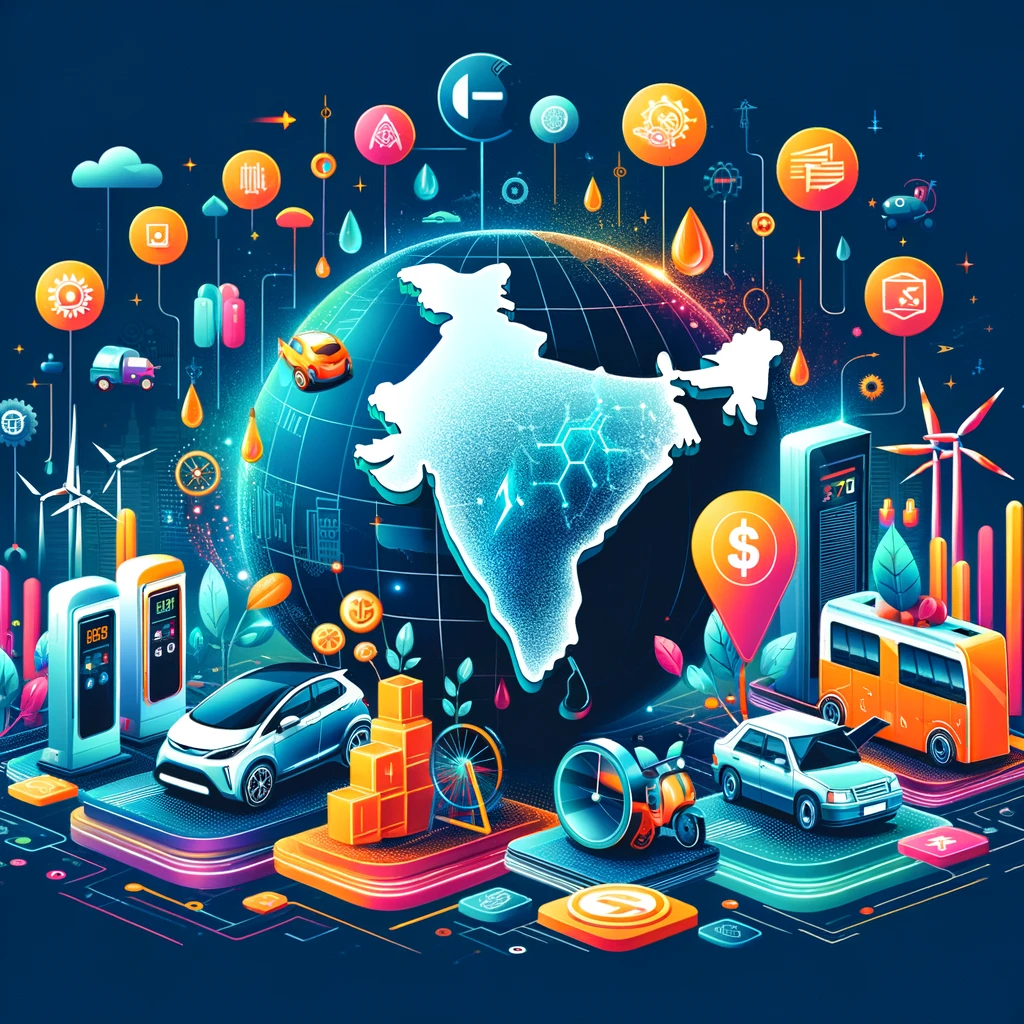
The Indian electric mobility market presents a compelling investment destination for international investors due to several factors:
- Government Initiatives and Policy Support: The Indian government has been actively promoting electric mobility through various policy initiatives and incentives. For example, the Faster Adoption and Manufacturing of (Hybrid &) Electric Vehicles (FAME) scheme provides subsidies for electric vehicle (EV) buyers and supports the development of charging infrastructure. As of my last update, FAME II was launched in 2019 with a budget of around $1.4 billion to encourage the adoption of EVs.
- Growing Demand and Market Potential: India’s rapidly growing population and urbanization are leading to increased demand for transportation solutions. With concerns over pollution and fuel prices, there’s a significant shift towards electric vehicles. According to a report by BloombergNEF, India is expected to be the fourth-largest passenger EV market by 2040, with sales reaching 10.7 million units.
- Infrastructure Development: The Indian government is investing in building charging infrastructure across the country.There are over 1,800 public charging stations in India, and the government aims to have around 22,000 charging stations by 2022.
- Partnerships and Collaborations: International companies are forging partnerships and collaborations with Indian firms to capitalize on the market opportunities. For instance, in 2021, Ola Electric, an Indian electric scooter manufacturer, announced a partnership with Siemens to build the world’s largest electric scooter manufacturing facility in Tamil Nadu, India.
- Innovative Solutions and Startups: The Indian electric mobility market is witnessing the emergence of innovative startups offering solutions across the value chain, from EV manufacturing to charging infrastructure and battery technology. Startups like Ather Energy, Revolt Motors, and Ola Electric have gained traction with their electric vehicle offerings.
- Supportive Regulatory Environment: The Indian government is working towards creating a conducive regulatory environment for electric mobility. This includes initiatives like setting targets for electric vehicle adoption, offering incentives for EV manufacturing, and promoting research and development in electric vehicle technology.
- Global Investment Interest: International companies and investors are showing keen interest in the Indian electric mobility market. For example, Tesla, one of the world’s leading electric vehicle manufacturers, has expressed its intention to enter the Indian market and has been exploring opportunities to set up a manufacturing facility in the country.
TOTAL EV MARKET SIZE IN INDIA:
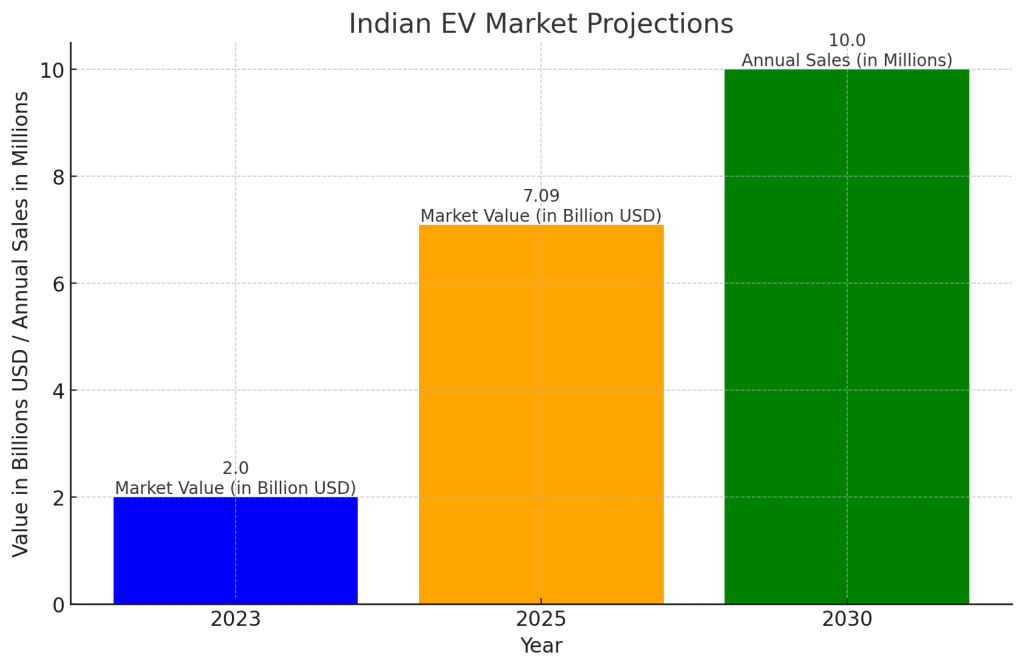
Projections indicate that the Indian EV market, valued at US$2 billion in 2023 could surge to US$7.09 billion by 2025. Industry estimates also forecast the domestic EV market to achieve 10 million annual sales by 2030.
KEY INDIAN PLAYERS IN INDIAN E-MOBILITY MARKET
Net Zero by Narsi
Insights and interactions on climate action by Narasimhan Santhanam, Director - EAI
View full playlist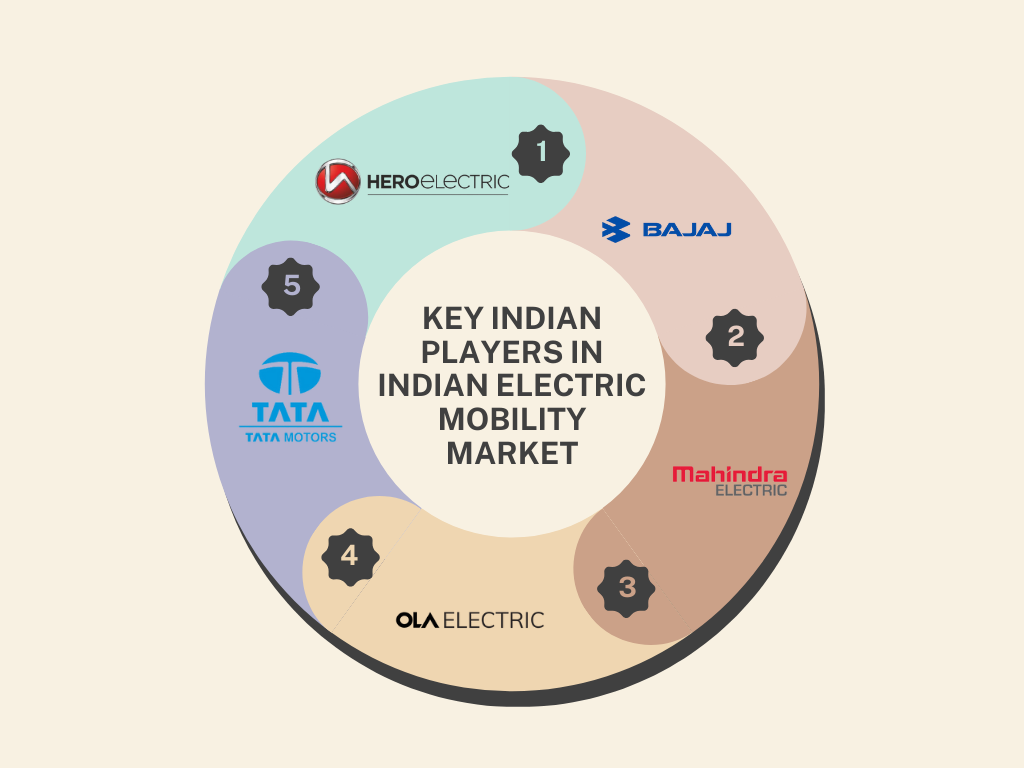
- Tata Motors:
- Tata Motors is one of India’s leading automotive manufacturers and a key player in the e-mobility market.
- Specific data points:
- Tata Motors launched the Tata Nexon EV, India’s first long-range electric SUV, in January 2020.
- The company has also announced plans to expand its electric vehicle portfolio with the introduction of more EV models across different segments.
- Mahindra Electric:
- Mahindra Electric Mobility Limited, a subsidiary of Mahindra & Mahindra, is a pioneer in electric vehicle technology in India.
- Specific data points:
- Mahindra Electric manufactures the Mahindra eVerito and Mahindra e2o Plus electric vehicles.
- The company has also collaborated with various government agencies and private companies to deploy electric vehicles for fleet applications.
- Hero Electric:
- Hero Electric is one of the largest electric two-wheeler manufacturers in India.
- Specific data points:
- Hero Electric offers a wide range of electric scooters, including models like the Hero Electric Optima, Flash, and Nyx.
- The company has a network of over 600 dealerships across India and aims to further expand its presence in the e-mobility market.
- Bajaj Auto:
- Bajaj Auto, a leading two-wheeler manufacturer in India, has entered the electric vehicle segment with its electric scooter, the Bajaj Chetak.
- Specific data points:
- Bajaj Chetak was launched in January 2020 and is available in select cities in India.
- The company has plans to expand the availability of the Bajaj Chetak to more cities and introduce more electric vehicle models in the future.
- Ola Electric:
- Ola Electric Mobility Pvt Ltd is a subsidiary of Ola Cabs, one of India’s largest ride-hailing companies.
- Specific data points:
- Ola Electric is working on developing electric two-wheelers, including electric scooters and motorcycles.
- The company has announced plans to set up a large-scale manufacturing facility for electric vehicles in Tamil Nadu, with an initial investment of $330 million.
KEY INTERNATIONAL AND GLOBAL PLAYERS IN INDIAN E-MOBILITY MARKET
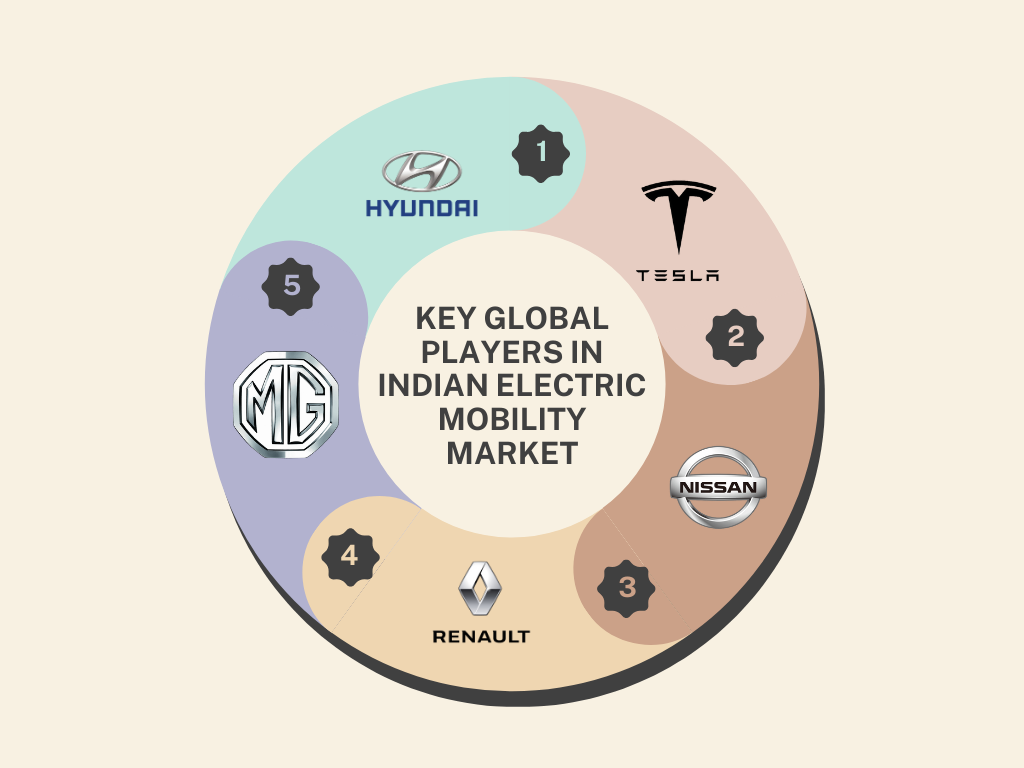
- Tesla:
- Tesla, Inc., an American electric vehicle and clean energy company, is one of the most prominent international players in the e-mobility market.
- Specific data points:
- Tesla announced its entry into the Indian market in 2021 and registered its Indian subsidiary, Tesla India Motors and Energy Pvt Ltd.
- The company plans to initially import and sell its electric vehicles in India before considering local manufacturing.
- Nissan:
- Nissan Motor Corporation, a Japanese multinational automobile manufacturer, has a presence in the Indian e-mobility market.
- Specific data points:
- Nissan launched the Nissan Leaf, an all-electric hatchback, in India in 2019.
- The Nissan Leaf was introduced as a part of the company’s strategy to promote electric mobility in the Indian market.
- Renault:
- Renault, a French multinational automobile manufacturer, has been actively involved in promoting electric mobility in India.
- Specific data points:
- Renault launched the Renault Kwid Electric concept at the 2020 Auto Expo in India, showcasing its commitment to electric mobility in the country.
- The company has expressed plans to introduce electric vehicles in the Indian market in the future.
- Hyundai:
- Hyundai Motor Company, a South Korean multinational automotive manufacturer, has a significant presence in the Indian e-mobility market.
- Specific data points:
- Hyundai launched the Hyundai Kona Electric, India’s first fully electric SUV, in July 2019.
- The Hyundai Kona Electric offers a range of over 450 kilometers on a single charge and has garnered positive reviews in the Indian market.
- MG Motor:
- MG Motor, a British automotive company owned by SAIC Motor Corporation Limited, has made a strong entry into the Indian e-mobility market.
- Specific data points:
- MG Motor launched the MG ZS EV, an all-electric SUV, in India in January 2020.
- The MG ZS EV offers a range of over 400 kilometers on a single charge and has been well-received in the Indian market.
GOVERNMENT POLICIES FOR INDIAN E-MOBILITY MARKET
Central Government Policies:
| Program | Launch/Budget | Objective | Specific Goal | Target |
|---|---|---|---|---|
| FAME India Phase II (April 2019) | April 2019 / ₹10,000 crores ($1.4 billion) | Provide financial incentives to buyers of electric and hybrid vehicles to reduce upfront purchase costs. | To encourage the adoption of electric mobility in India by providing upfront incentives on the purchase of electric vehicles and by establishing the necessary charging infrastructure to support electric vehicles | Encouraging the adoption of 7,090 eBuses, 5 lakh e-3 Wheelers, 55,000 e-4 Wheeler Passenger Cars, and 10 lakh e-2 Wheelers. |
| FAME India Phase II Update (July 2021) | July 2021 / ₹18,100 crores ($2.5 billion) | Provide financial incentives to buyers of electric and hybrid vehicles to reduce upfront purchase costs. | The specific goal of this enhanced FAME India Phase II was not only to continue providing financial incentives to boost the adoption of electric and hybrid vehicles but also to significantly expand the charging infrastructure across the country. | This phase aimed to generate demand by way of supporting 7000 e-Buses, 5 lakh e-3 Wheelers, 55000 e-4 Wheeler Passenger Cars (including Strong Hybrid) and 10 lakh e-2 Wheelers. |
| National Electric Mobility Mission Plan (NEMMP) | 2013 | Promote the adoption of electric vehicles and develop a robust electric mobility ecosystem in India. | Achieve 30% electric vehicles on Indian roads by 2030. | 6-7 million electric vehicles on Indian roads by 2020. |
State Government Policies:
- Electric Vehicle Policies:
- Several state governments in India have introduced electric vehicle (EV) policies to encourage the adoption of electric vehicles and support the development of charging infrastructure.
- States like Delhi, Maharashtra, Karnataka, Telangana, and Tamil Nadu have announced their own EV policies with various incentives such as subsidies, exemptions from road tax, and registration fees for electric vehicles.
- Specific data points:
- Maharashtra’s Electric Vehicle Policy 2021 offers incentives such as subsidies up to ₹5,00,000 (approximately $6,800) for electric cars and ₹1,50,000 (approximately $2,000) for electric two-wheelers.
- Charging Infrastructure Development:
- State governments are also focusing on developing charging infrastructure to support the growth of electric mobility.
- Many states have announced plans to set up public charging stations for electric vehicles in strategic locations such as highways, commercial hubs, and residential areas.
- Specific data points:
- Karnataka’s Electric Vehicle and Energy Storage Policy 2017 aims to set up 6,000 electric vehicle charging stations across the state by 2023.
GROWTH PROSPECTS IN INDIA FOR THE PROMINENT E-MOBILITY VALUE CHAIN COMPONENTS
- Electric Vehicles (EVs):
- The Indian government has set ambitious targets for electric vehicle adoption through initiatives like the Faster Adoption and Manufacturing of Hybrid and Electric Vehicles (FAME) scheme.
- Specific data points:
- The Society of Indian Automobile Manufacturers (SIAM) predicts that electric vehicle sales in India could reach 10-12% of total vehicle sales by 2030.
- According to a report by EY India, the Indian electric vehicle market is expected to reach 63 million units by 2030, driven by factors like declining battery costs and supportive government policies.
- Battery Manufacturing:
- Battery manufacturing is a critical component of the e-mobility value chain, and India aims to become a global hub for battery manufacturing.
- Specific data points:
- The Indian government’s National Programme on Advanced Chemistry Cell (ACC) Battery Storage aims to support the setting up of gigafactories for advanced cell chemistry battery manufacturing.
- India plans to attract investments of $40 billion in the battery manufacturing ecosystem by 2030, as per the Ministry of New and Renewable Energy (MNRE).
- Charging Infrastructure:
- The availability of charging infrastructure is crucial for the widespread adoption of electric vehicles.
- Specific data points:
- The Indian government has announced plans to set up one charging station for every 25 km on highways and major roads, as per the FAME II scheme.
- The Electric Vehicle Charging Guidelines 2021 aim to provide a roadmap for the establishment of charging infrastructure, including norms for public charging stations and home charging facilities.
- Electric Vehicle Components:
- Various components such as electric motors, power electronics, and onboard chargers are essential for electric vehicle manufacturing.
- Specific data points:
- The Electric Vehicle Policy of India aims to promote the manufacture of electric vehicle components and provide incentives for research and development in this sector.
- The Indian Electric Vehicle Market Forecast & Opportunities 2021-2026 report projects a CAGR of over 37% for the electric vehicle components market in India during the forecast period.
- Software and Connectivity:
- Software and connectivity solutions are increasingly important for electric vehicles, enabling features like remote monitoring, over-the-air updates, and vehicle-to-grid integration.
- Specific data points:
- The Indian automotive software market is expected to reach $2.5 billion by 2025, driven by the adoption of electric and connected vehicles, as per a report by MarketsandMarkets.
- Indian startups like Ola Electric, Ather Energy, and Revolt Intellicorp are focusing on developing software and connectivity solutions for electric vehicles, contributing to the growth of this segment.
FAST GROWING SECTORS WITHIN THE INDIAN E-MOBILITY SECTOR
- Electric Two-Wheelers (E2Ws):
- Electric two-wheelers are one of the fastest-growing segments in the Indian e-mobility sector, driven by factors such as lower operating costs, government incentives, and growing consumer interest.
- Specific data points:
- According to the Society of Indian Automobile Manufacturers (SIAM), electric two-wheeler sales in India grew by over 140% in FY2020-21 compared to the previous year, reaching approximately 1.52 lakh units.
- The Electric Vehicle Market Report 2021 by EV Market Research estimates that the Indian electric two-wheeler market will grow at a CAGR of over 45% during 2021-2026.
- Electric Three-Wheelers (E3Ws):
- Electric three-wheelers, particularly e-rickshaws and e-autos, are experiencing significant growth in India due to their suitability for last-mile connectivity, lower operating costs, and government initiatives promoting clean mobility solutions.
- Specific data points:
- According to EV Market Research, the Indian electric three-wheeler market is expected to grow at a CAGR of around 16% during 2021-2026.
- The Ministry of Heavy Industries and Public Enterprises reported that over 700,000 electric three-wheelers were sold in India under the FAME II scheme till August 2021.
- Electric Passenger Cars:
- Electric passenger cars are gaining traction in India as consumers seek environmentally friendly alternatives to traditional internal combustion engine vehicles.
- Specific data points:
- Electric passenger car sales in India witnessed significant growth in FY2020-21, with over 5,500 units sold compared to around 1,400 units in the previous year, according to SIAM.
- The Electric Vehicle Market Report 2021 forecasts that the Indian electric passenger car market will grow at a CAGR of around 44% during 2021-2026.
- Electric Buses:
- Electric buses are emerging as a sustainable mass transit solution in Indian cities, driven by government initiatives promoting electric public transportation and the need to address urban air pollution.
- Specific data points:
- According to EV Market Research, the Indian electric bus market is expected to grow at a CAGR of around 18% during 2021-2026.
- The Ministry of Heavy Industries and Public Enterprises reported that over 600 electric buses were sanctioned for various cities under the FAME II scheme till August 2021.
- Charging Infrastructure:
- The demand for electric vehicle charging infrastructure is increasing in India to support the growing fleet of electric vehicles and encourage adoption by addressing range anxiety among consumers.
- Specific data points:
- The Indian government has approved the installation of over 14,000 electric vehicle charging stations across the country under the FAME II scheme.
- According to EV Market Research, the Indian electric vehicle charging infrastructure market is expected to grow at a CAGR of around 42% during 2021-2026.
E-MOBILITY SECTORS THAT ARE LIKELY TO SHOW MUCH HIGHER GROWTH POST 2025
- Electric Passenger Cars:
- Key Drivers: Continued advancements in battery technology, declining battery costs, increasing consumer awareness, and government incentives promoting electric vehicle adoption.
- Specific Data Points:
- BloombergNEF forecasts that electric vehicles will account for 58% of global passenger car sales by 2040, indicating significant growth potential beyond 2025.
- The International Energy Agency (IEA) projects that India’s electric passenger car stock will reach around 30 million by 2030, driven by supportive policies and decreasing battery costs.
- Electric Two-Wheelers (E2Ws):
- Key Drivers: Rising urbanization, growing demand for affordable and sustainable urban mobility solutions, improving charging infrastructure, and government incentives.
- Specific Data Points:
- The EV Market Research report estimates that the Indian electric two-wheeler market will grow at a CAGR of over 45% during 2021-2026, indicating strong growth potential post-2025.
- Increasing consumer interest in electric scooters and motorcycles, along with expanding product portfolios from manufacturers, is expected to drive higher growth in this segment post-2025.
- Electric Three-Wheelers (E3Ws):
- Key Drivers: Increasing adoption for last-mile connectivity, government policies promoting electric mobility in the commercial vehicle segment, and technological advancements.
- Specific Data Points:
- The Indian electric three-wheeler market is expected to grow at a CAGR of around 16% during 2021-2026, according to EV Market Research.
- The Ministry of Heavy Industries and Public Enterprises reported that over 700,000 electric three-wheelers were sold in India under the FAME II scheme till August 2021, indicating strong growth potential post-2025 as awareness and infrastructure improve.
- Electric Buses:
- Key Drivers: Government initiatives promoting electric public transportation, rising concerns about urban air pollution, improving technology, and decreasing battery costs.
- Specific Data Points:
- The Indian electric bus market is expected to grow at a CAGR of around 18% during 2021-2026, according to EV Market Research, indicating significant growth potential post-2025.
- The Ministry of Heavy Industries and Public Enterprises reported that over 600 electric buses were sanctioned for various cities under the FAME II scheme till August 2021, with more deployments expected in the coming years.
- Charging Infrastructure:
- Key Drivers: Increasing electric vehicle adoption, government investments in charging infrastructure, technological advancements in charging technology, and private sector participation.
- Specific Data Points:
- The Indian electric vehicle charging infrastructure market is expected to grow at a CAGR of around 42% during 2021-2026, according to EV Market Research, indicating strong growth potential post-2025.
- The Indian government has approved the installation of over 14,000 electric vehicle charging stations across the country under the FAME II scheme, with more investments expected post-2025 to support the growing electric vehicle fleet.
KEY CHALLENGES FACED BY INDIAN ELECTRIC MOBILITY MARKET
- High Initial Cost: Electric vehicles (EVs) generally have a higher upfront cost compared to conventional internal combustion engine vehicles. This higher cost is primarily due to the expensive battery technology used in EVs. Despite various incentives and subsidies provided by the government, the initial cost of purchasing an EV remains a significant barrier for many consumers.
- Limited Charging Infrastructure: The availability of charging infrastructure is crucial for the widespread adoption of electric vehicles. However, in India, the charging infrastructure remains limited, particularly in non-metro cities and rural areas. The lack of charging stations and the time required for charging deter potential buyers from considering EVs as a viable option, especially for long-distance travel.
- Range Anxiety: Range anxiety refers to the fear of running out of battery charge while driving an electric vehicle. Despite improvements in battery technology, many consumers still perceive EVs as having limited range compared to conventional vehicles. This perception acts as a barrier to adoption, particularly for those who need to travel long distances regularly.
- Battery Technology and Performance: The performance and longevity of batteries used in electric vehicles are critical factors influencing consumer acceptance. Issues such as battery degradation over time, limited driving range per charge, and concerns about battery safety and reliability impact consumer confidence in EVs. Additionally, the lack of widespread recycling and disposal infrastructure for used batteries raises environmental concerns.
- Lack of Consumer Awareness: There is a lack of awareness and understanding among consumers regarding the benefits and features of electric vehicles. Many potential buyers are unfamiliar with EV technology, charging infrastructure, government incentives, and overall cost savings associated with owning an EV. This lack of awareness hampers consumer confidence and adoption.
- Infrastructure Challenges: Apart from charging infrastructure, other infrastructure challenges such as inadequate road infrastructure, traffic congestion, and parking facilities also affect the adoption of electric vehicles. Limited public transportation options and last-mile connectivity issues in urban and rural areas further impede the uptake of EVs.
KEY INNOVATIONS DRIVING INDIAN ELECTRIC MOBILITY MARKET
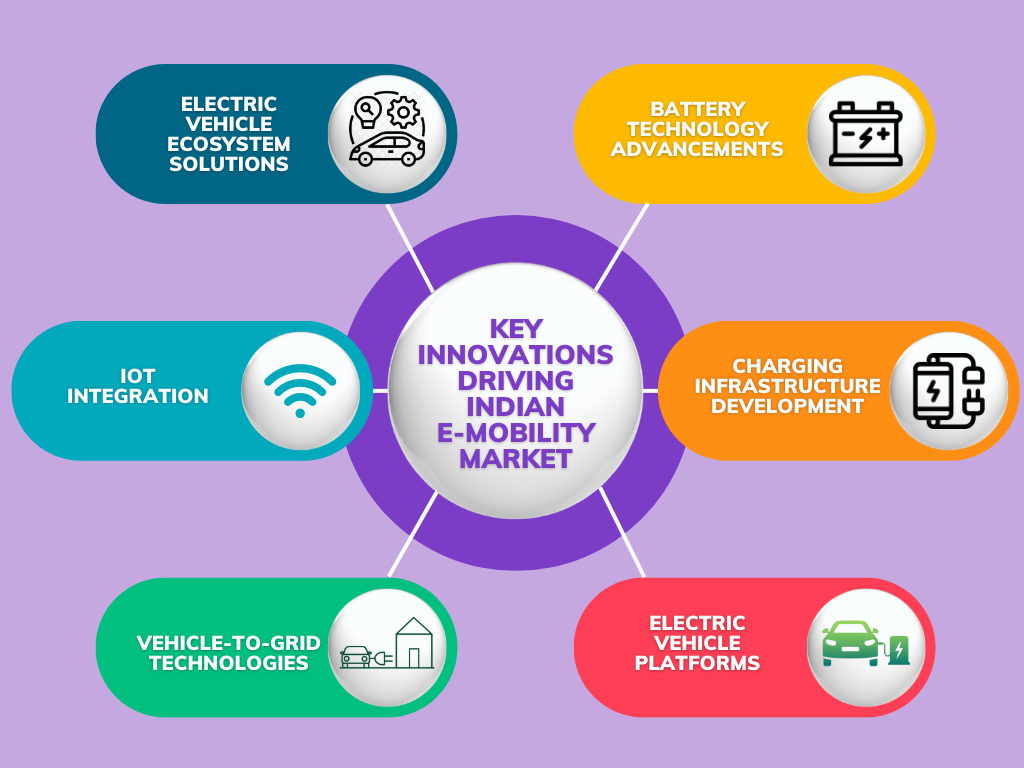
- Battery Technology Advancements: Continuous advancements in battery technology are driving the growth of the electric mobility market. Innovations in battery chemistry, such as lithium-ion batteries, are leading to improvements in energy density, charging speed, and lifespan, making electric vehicles more viable and attractive to consumers.
- Charging Infrastructure Development: Innovations in charging infrastructure are essential for the widespread adoption of electric vehicles. Rapid development of charging infrastructure, including fast-charging stations and innovative charging solutions for residential, commercial, and public spaces, is making EV charging more convenient and accessible for consumers.
- Electric Vehicle Platforms: Innovative electric vehicle platforms, including skateboard-style platforms and modular architectures, are enabling the development of a wide range of electric vehicles, including cars, scooters, and bicycles. These platforms offer flexibility, scalability, and cost-efficiency for electric vehicle manufacturers, driving innovation in vehicle design and performance.
- Vehicle-to-Grid (V2G) Technology: Vehicle-to-Grid (V2G) technology enables bidirectional energy flow between electric vehicles and the grid, allowing EVs to serve as energy storage devices and participate in demand-response programs. This innovative technology not only enhances grid stability and reliability but also provides new revenue streams for EV owners, driving the adoption of electric vehicles.
- Internet of Things (IoT) Integration: Integration of IoT technology in electric vehicles enables connectivity, data analytics, and remote monitoring, enhancing vehicle performance, efficiency, and user experience. IoT-enabled features such as remote diagnostics, over-the-air updates, and predictive maintenance are driving innovation in electric vehicle technology and enhancing customer satisfaction.
- Electric Vehicle Ecosystem Solutions: Innovative solutions and services for the electric vehicle ecosystem, including battery swapping, subscription-based models, and mobility-as-a-service (MaaS) platforms, are driving the adoption of electric vehicles. These solutions address key challenges such as range anxiety, high upfront costs, and charging infrastructure limitations, making electric mobility more accessible and affordable for consumers.
KEY OPPORTUNITY SEGMENTS FOR INTERNATIONAL FIRMS IN INDIAN E-MOBILITY MARKET
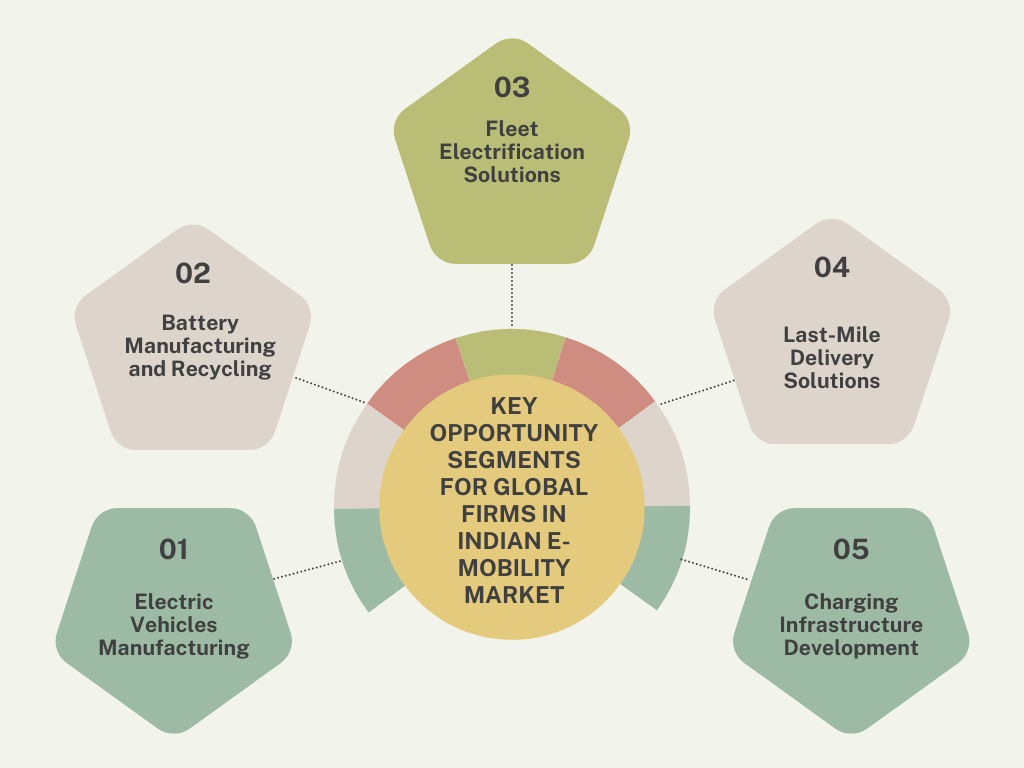
- Electric Vehicles (EVs) Manufacturing: With the Indian government’s ambitious plans to electrify the country’s transportation sector, there is a significant opportunity for international firms to invest in the manufacturing of electric vehicles. This includes passenger cars, two-wheelers, three-wheelers, and commercial vehicles. International firms can leverage their expertise in EV technology, design, and manufacturing to cater to the growing demand in the Indian market.
- Charging Infrastructure Development: The expansion of charging infrastructure is critical to support the adoption of electric vehicles in India. International firms specializing in electric vehicle charging solutions can capitalize on this opportunity by partnering with local governments, businesses, and other stakeholders to deploy charging stations across urban and rural areas. This includes fast-charging stations, public charging networks, and residential charging solutions.
- Battery Manufacturing and Recycling: Batteries are a crucial component of electric vehicles, and there is a growing demand for advanced battery technologies in the Indian market. International firms with expertise in battery manufacturing and recycling can explore opportunities to establish battery manufacturing facilities and recycling plants in India. This includes lithium-ion batteries, solid-state batteries, and other advanced battery technologies.
- Electric Vehicle Components and Technologies: International firms specializing in electric vehicle components and technologies, such as motors, power electronics, and energy management systems, can collaborate with Indian OEMs and suppliers to supply advanced components for electric vehicles. This includes electric drivetrain systems, battery management systems, and vehicle-to-grid (V2G) technologies.
- Fleet Electrification Solutions: With the increasing focus on sustainable mobility solutions, there is a growing demand for fleet electrification solutions in India. International firms specializing in fleet management, telematics, and electric vehicle leasing can provide comprehensive solutions to fleet operators looking to transition to electric vehicles. This includes fleet electrification consulting, vehicle leasing programs, and fleet management software.
- Last-Mile Delivery Solutions: Last-mile delivery is a key segment for electrification, especially in urban areas where pollution and congestion are significant challenges. International firms specializing in electric cargo bikes, scooters, and three-wheelers can provide solutions for e-commerce companies, logistics providers, and food delivery services looking to electrify their last-mile delivery fleets.
- Mobility as a Service (MaaS) Platforms: Mobility as a Service platforms are gaining traction in India, offering integrated, multi-modal transportation solutions to users. International firms with expertise in MaaS platforms, ride-sharing apps, and mobility analytics can collaborate with Indian startups and transportation companies to develop and deploy innovative mobility solutions that integrate electric vehicles into the transportation ecosystem.


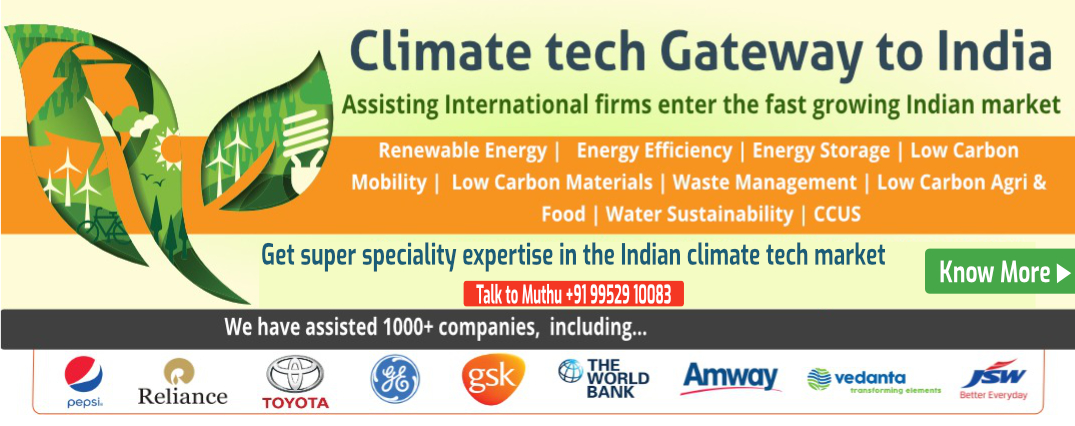



 Our specialty focus areas include
Our specialty focus areas include




